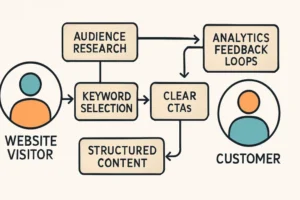Creating Content That Converts, Strategies for SEO Success
Key Takeaways
- Understand your audience deeply to tailor content that genuinely meets their needs and interests.
- Conduct comprehensive keyword research to target the most relevant and high-intent search terms.
- Optimize your content structure for easy readability and enhanced SEO performance.
- Incorporate persuasive, actionable calls-to-action (CTAs) to guide users toward the next steps.
- Use data analytics intensively to evaluate performance and continually improve your strategies.
In today’s highly competitive digital world, drawing traffic to your website is just the first step turning visitors into valuable leads or loyal customers is the accurate benchmark of digital marketing success. Modern brands need to go beyond superficial strategies by integrating robust content marketing services with SEO best practices. This powerful synergy enhances visibility on search engines, attracts high-quality audiences, and encourages meaningful actions that directly align with your business goals. A well-balanced approach not only helps your brand get noticed but establishes your site as an authority, reassuring readers they are in the right place to find solutions to their needs.
Unlike traditional static web copy, SEO content that delivers results must accomplish several key objectives simultaneously: it must rank well on search engines, create genuine value for readers, foster trust, and prompt purposeful engagement. The real secret isn’t just about casting a wide net with keywords it’s about nurturing visitors along the path from curiosity to conversion. In this comprehensive guide, we explore actionable strategies to refine your content for increased conversions and sustained growth, ensuring your marketing efforts yield tangible business results.
Understanding Your Audience
Truly effective content creation begins not with keywords or headlines, but with a thorough understanding of your intended audience. The more you know about your target market ranging from demographic information such as age, location, and occupation, to deeper insights like their motivators, goals, and daily challenges the better you can shape content that matters to them. This crucial groundwork is laid by creating detailed buyer personas and mapping typical customer journeys to uncover the content topics, tones, and formats that will resonate most powerfully with your readers.
Gaining this level of audience understanding often involves closely examining your existing customers, leveraging CRM data, and actively listening to feedback received through support channels, reviews, and surveys. Social media is another goldmine for real-time insights into trending concerns and language customers use valuable pointers for refining your messaging. The data you gather helps you anticipate your audience’s needs, answer their most pressing questions, and demonstrate empathy, which builds trust and keeps them coming back for more.
Tips to Define Your Ideal Audience
- Identify the age, gender, geographic location, occupation, and personal interests of audience segments to get a holistic view.
- Look for patterns in common challenges, pain points, and frequently asked questions that are posted in forums, customer emails, or interviews.
- Thoroughly map out your typical customer’s journey from initial awareness through consideration to conversion or purchase.
The clearer your picture of your readers, the more targeted your content can be, allowing you to guide, educate, and persuade them far more effectively.

Conducting Keyword Research
Keyword research stands as the cornerstone of any successful SEO campaign, setting the direction for the topics your content will address. To do this effectively, go beyond just identifying popular or high-volume phrases dig deeper to find keywords that your preferred audience uses naturally and that signal straightforward buying or inquiry intent. Advanced tools make this less of a guessing game by providing data on monthly search volumes, keyword difficulty, and even which terms your competitors are targeting.
An impactful approach blends both broad “head” keywords for visibility and highly specific long-tail keywords that match detailed user queries. Over time, focusing on these high-intent, less competitive terms enables you to rank faster and attract an audience that is further down the sales funnel and more likely to convert. Regularly revisit your keyword strategy to address any gaps revealed by evolving search behavior, competitor movements, or shifts in your business offerings. Align these keywords with each stage of the customer’s journey to ensure ongoing relevance and contextual authority for every visitor that lands on your site.
Effective Keyword Strategies
- Target a flexible mix of short-tail (broader) and long-tail (niche-focused) keywords, adapting as performance trends emerge.
- Study your competitors to uncover keyword opportunities they may be overlooking or weaknesses you can capitalize on.
- Map chosen keywords directly to each buyer journey stage, ensuring content meets users exactly where they are.
Ultimately, targeting keywords based on user intent rather than just volume positions your content to both rank high on search results and attract visitors most likely to take action, completing the conversion cycle.
Optimizing Content Structure
How you present information is just as important as what you say, and optimizing content structure ensures that your message is accessible to both human readers and search engine bots. Organize your article with clear, descriptive headings, utilizing H1, H2, and H3 tags not only for SEO benefits but also to help visitors navigate easily. Thoughtfully structured sections, as demonstrated by this Search Engine Land content optimization guide, let audiences quickly scan for the information they care about most.
Use concise blocks of text, bulleted or numbered lists, and visual formatting when appropriate. This enhances scannability and clearly communicates key points, particularly to users scanning on mobile devices. Place the most essential information early, hook readers in the first few moments, and then provide supporting details and rich media later on. Repeating your CTAs at natural breakpoints reinforces the call to action without feeling forced. Not only does this structure make users more likely to stay and engage, but it also provides search engines with a clearer understanding of your content hierarchy and relevance.
Best Practices for Structuring Content
- Use semantic and meaningful heading tags (like H1 for your main title and H2/H3 for subtopics) to signal both organization and keyword relevance.
- Incorporate ordered and unordered lists to break up complex points and highlight actionable takeaways.
- Front-load key information, placing must-know insights at the top and repeating CTAs at both logical progression points and at the end.
Ultimately, a logical, well-structured format doesn’t just improve readability it enhances accessibility, reduces bounce rates, and increases the likelihood your audience will complete your desired action.
Crafting Compelling CTAs
No matter how engaging your article is, conversions will remain elusive without strategic, persuasive CTAs (calls-to-action). CTAs are critical checkpoints, nudging your audience towards their next step, whether signing up for a newsletter, downloading a guide, making a purchase, or even simply reading another article. To drive conversions, your CTAs must be clear, action-oriented, and convey immediate value people should know exactly what’s in it for them when they click.
Effective CTAs use commanding, positive language that encourages immediate action and highlights tangible benefits. The best-performing CTAs make the next step feel both easy and rewarding, and their placement is carefully considered, appearing not just at the end but also midway through the content and in eye-catching areas, such as sidebars or pop-ups. As outlined in Forbes’ guide on crafting compelling calls to action, optimizing CTA phrasing, design, and relevance can dramatically boost engagement. For even greater impact, tailor CTAs to match each visitor’s intent and position in the sales funnel. Personalized CTAs that speak directly to the user’s context or previous behavior consistently outperform generic messaging.
How to Create High-Converting CTAs
- Utilize strong, direct action verbs like “Start Your Free Trial,” “Access the Guide,” or “See Plans & Pricing.”
- Highlight specific user benefits, such as “Save Time,” “Unlock Tips,” or “Get Exclusive Insights Free.”
- Deploy CTAs in multiple strategic locations at the start, middle, and end and always within a relevant context, so users are never confused about their next step.
Leveraging Data Analytics
Continuous improvement is fueled by actionable insights. Measuring how your content performs with analytics tools, such as Google Analytics and Google Search Console, forms the backbone of an iterative content strategy. By closely tracking user behavior traffic sources, engagement metrics, bounce rates, and, most importantly, conversion rates you gain a clear picture of what resonates with your audience and where friction points exist.
Analyzing this data goes far beyond tracking high-level numbers. Assess individual page performance to identify which pieces of content most effectively aid your conversion funnel and which may require more strategic optimization. Monitor the full conversion path to understand the journey users take before completing a form, downloading, or making a purchase, and then fine-tune your offerings based on these patterns. Regularly revisiting keyword and CTA performance also reveals new opportunities as search trends evolve.
Optimizing Strategy with Data
- Regularly monitor key metrics, such as session duration, bounce rate, and goal completions, to identify areas for improvement.
- Use conversion path analysis to credit supporting content that nudges users to take action, not just last-touch conversions.
- Adjust strategy dynamically to capitalize on newly discovered keyword trends and high-potential topics emerging from analytics data.
By embracing advanced audience research, strategic keyword mapping, organized content structuring, and thoughtfully crafted CTAs all while relentlessly tracking and improving through analytics you can build content that not only climbs the search rankings, but more importantly, converts visitors into advocates, leads, and customers, ensuring ongoing business growth and success.


